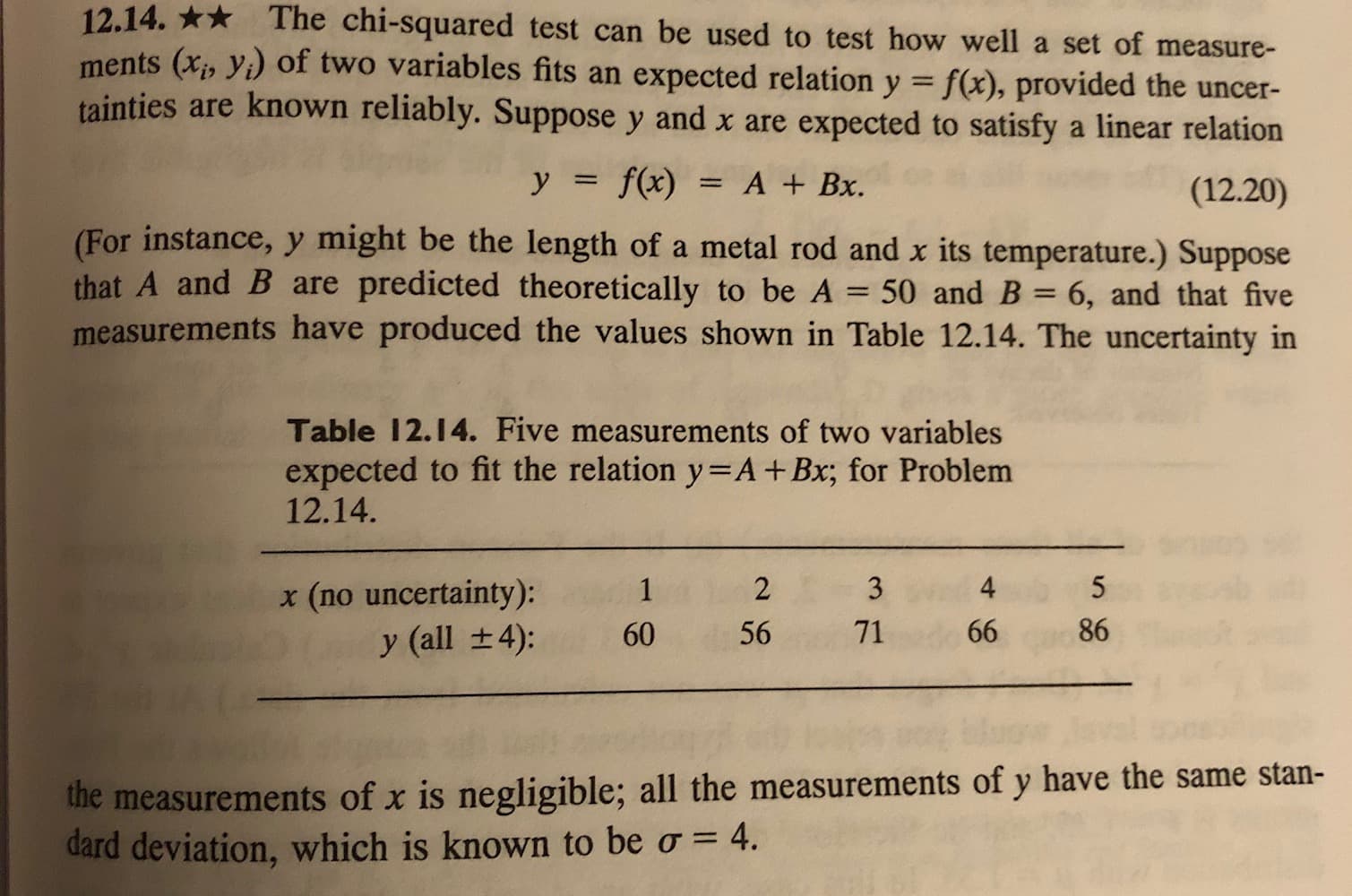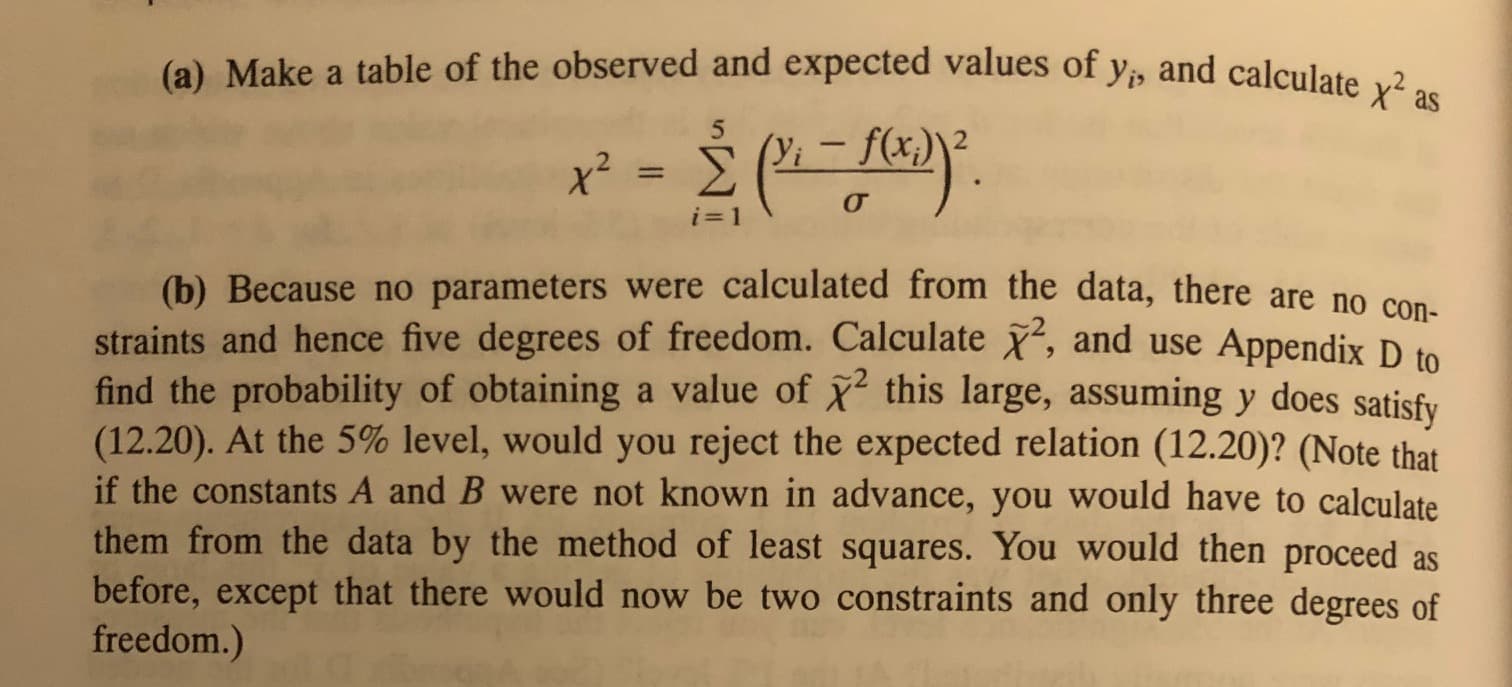12.14. The chi-squared test can be used to test how well a set of measure- ments (xi, yi) of two variables fits an expected relation y f(x), provided the uncer- tainties are known reliably. Suppose y and x are expected to satisfy a linear relation y = f(x)=A + Bx. (12.20) (For instance, y might be the length of a metal rod and x its temperature.) Suppose that A and B are predicted theoretically to be A 50 and B 6, and that five measurements have produced the values shown in Table 12.14. The uncertainty in Table 12.14. Five measurements of two variables expected to fit the relation y-A + Bx; for Problem 12.14. 4 5 2 x (no uncertainty): y (all +4): 1 86 66 71 56 60 the measurements of x is negligible; all the measurements of y have the same stan- dard deviation, which is known to be o 4. (a) Make a table of the observed and expected values of y, and calculate x as x = (f) о i 1 (b) Because no parameters were calculated from the data, there are no con- straints and hence five degrees of freedom. Calculate , and use Appendix D to value of 2 this large, assumingy does satisfy find the probability of obtaining (12.20). At the 5% level, would you reject the expected relation (12.20)? (Note that if the constants A and B were not known in advance, you would have to calculate them from the data by the method of least squares. You would then proceed as before, except that there would now be two constraints and only three degrees of freedom.)
12.14. The chi-squared test can be used to test how well a set of measure- ments (xi, yi) of two variables fits an expected relation y f(x), provided the uncer- tainties are known reliably. Suppose y and x are expected to satisfy a linear relation y = f(x)=A + Bx. (12.20) (For instance, y might be the length of a metal rod and x its temperature.) Suppose that A and B are predicted theoretically to be A 50 and B 6, and that five measurements have produced the values shown in Table 12.14. The uncertainty in Table 12.14. Five measurements of two variables expected to fit the relation y-A + Bx; for Problem 12.14. 4 5 2 x (no uncertainty): y (all +4): 1 86 66 71 56 60 the measurements of x is negligible; all the measurements of y have the same stan- dard deviation, which is known to be o 4. (a) Make a table of the observed and expected values of y, and calculate x as x = (f) о i 1 (b) Because no parameters were calculated from the data, there are no con- straints and hence five degrees of freedom. Calculate , and use Appendix D to value of 2 this large, assumingy does satisfy find the probability of obtaining (12.20). At the 5% level, would you reject the expected relation (12.20)? (Note that if the constants A and B were not known in advance, you would have to calculate them from the data by the method of least squares. You would then proceed as before, except that there would now be two constraints and only three degrees of freedom.)
Algebra & Trigonometry with Analytic Geometry
13th Edition
ISBN:9781133382119
Author:Swokowski
Publisher:Swokowski
Chapter7: Analytic Trigonometry
Section7.6: The Inverse Trigonometric Functions
Problem 92E
Related questions
Question
100%

Transcribed Image Text:12.14.
The chi-squared test can be used to test how well a set of measure-
ments (xi, yi) of two variables fits an expected relation y f(x), provided the uncer-
tainties are known reliably. Suppose y and x are expected to satisfy a linear relation
y = f(x)=A + Bx.
(12.20)
(For instance, y might be the length of a metal rod and x its temperature.) Suppose
that A and B are predicted theoretically to be A 50 and B
6, and that five
measurements have produced the values shown in Table 12.14. The uncertainty in
Table 12.14. Five measurements of two variables
expected to fit the relation y-A + Bx; for Problem
12.14.
4
5
2
x (no uncertainty):
y (all +4):
1
86
66
71
56
60
the measurements of x is negligible; all the measurements of y have the same stan-
dard deviation, which is known to be o 4.

Transcribed Image Text:(a) Make a table of the observed and expected values of y, and calculate x as
x = (f)
о
i 1
(b) Because no parameters were calculated from the data, there are no con-
straints and hence five degrees of freedom. Calculate , and use Appendix D to
value of 2 this large, assumingy does satisfy
find the probability of obtaining
(12.20). At the 5% level, would you reject the expected relation (12.20)? (Note that
if the constants A and B were not known in advance, you would have to calculate
them from the data by the method of least squares. You would then proceed as
before, except that there would now be two constraints and only three degrees of
freedom.)
Expert Solution
This question has been solved!
Explore an expertly crafted, step-by-step solution for a thorough understanding of key concepts.
This is a popular solution!
Trending now
This is a popular solution!
Step by step
Solved in 4 steps with 2 images

Recommended textbooks for you

Algebra & Trigonometry with Analytic Geometry
Algebra
ISBN:
9781133382119
Author:
Swokowski
Publisher:
Cengage

Algebra & Trigonometry with Analytic Geometry
Algebra
ISBN:
9781133382119
Author:
Swokowski
Publisher:
Cengage